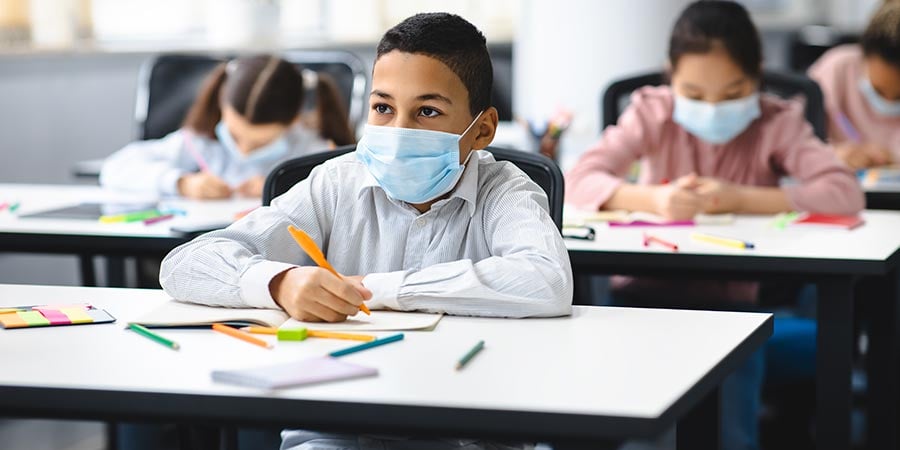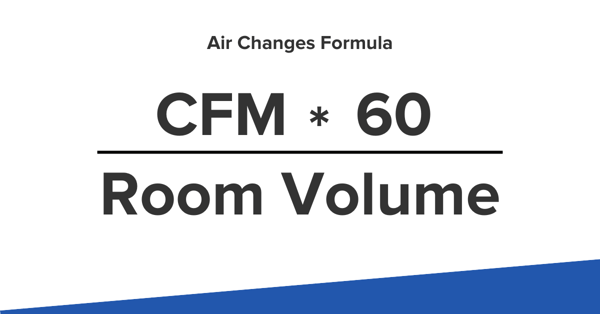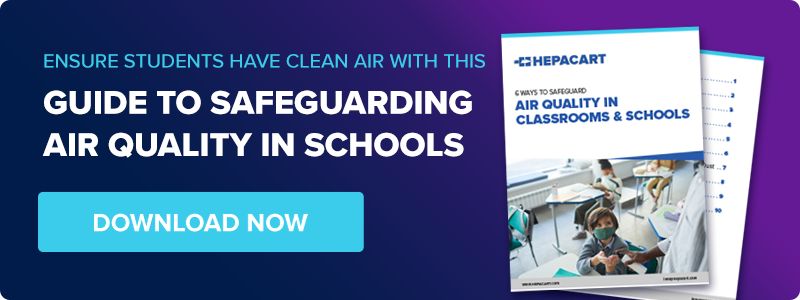Share this
How to Calculate Air Changes Per Hour to Achieve a Safe Classroom
by HEPACART on Jan 10, 2023

Every school’s top priority should be the health and safety of students, teachers, and faculty. Creating a healthy and engaging learning environment is essential to see the students succeed. The facility’s indoor air quality is one of the most important ways to ensure a healthy environment for everyone. Though it is often not thought about or is pushed to the back burner, when indoor air quality is poor, it can have a negative impact on a student's performance. According to the United States Environmental Protection Agency, indoor air quality is one of the top five environmental risks to public health. Polluted air can cause coughing, eye irritation, allergic reactions and even spur asthma attacks. In order to promote a healthy learning environment, a school must evaluate its indoor air quality.
As a facility manager, it is your responsibility to ensure that indoor air quality promotes learning and positive performance. If the indoor air quality is poor, do not be surprised when it has a negative impact on your school’s operations. How do you know that the air quality in your school is positive? Calculating the air changes per hour is essential to reaching acceptable air quality. Keep reading to learn more about air changes per hour, how to calculate them, and best practices for managing your air quality.
What Does Air Changes Per Hour Mean?
Air changes per hour is a way to measure how many times each hour outside air enters a space and is mixed and replaces old air from inside. For example, if the air changes per hour rate is three, it means that the room’s entire volume of air is replaced with new air three times during each hour. The American Society of Heating, Refrigerating, and Air-Conditioning Engineers (ASHRAE) recommends that schools should have an air ventilation rate of 5-6 times per hour. This means that outside air should enter a facility or room 5-6 times per hour.
Why Is It Important?
Calculating the air changes per hour gives you insight into the classrooms’ air quality, ventilation, and cleanliness. It can offer valuable information that will help you determine which kind of air purifier for dust you would need and how many of them. Ventilation is of the utmost importance to maintain the good air quality in a large facility, especially when there are many people in the space. By examining a room’s air changes per hour rate, you can determine if the space is improperly ventilated. When that is not accurate, it will allow pollutants in the air to build up and can affect a person’s health. Without knowing the air changes per hour rate, it is difficult to know if your facility is properly ventilated.
The Formula
The air changes per hour formula is simple: multiply the cubic feet per minute (CFM) of your filtration device by 60 and then divide that number by the total volume (V) of air being exchanged.
ACH = CFM(60) / V

However, in order to correctly calculate the air change per hour, you need to know the volume of air. To find the volume, multiply the length, width, and height of a room.
V = L * W * H
For example, a standard classroom in the United States is around 1,000 square feet in size and has a minimum ceiling height of 9 feet. If we were examining a classroom with these exact measurements, it would have a volume of 9,000 cubic feet.
To find the CFM to complete the equation, you will need to examine your current HVAC system. Once you have that figure, complete the equation to find out what the air changes per hour rate is for the classroom. Keep in mind that ASHRAE has a recommended air ventilation rate of 5-6 per classroom.
How Can I Manage the Air Quality?
As a facility manager, maintaining the air quality is an essential part of your job. By ensuring students and faculty are exposed to clean air, you are working towards better health and higher productivity for those in the classroom. Here are some practical ways you can manage your facility’s air quality.
Air Quality Monitoring
Knowing the state of your indoor air quality is crucial before you proceed any further. Many air quality monitors are available online and can give you accurate information so you know which next steps are right for your facility. The outside air does not have to work hard to find its way inside. While this can be beneficial, the outdoor air quality can also be poor at times. Depending on if your facility is located in the city or a more rural part of the country, monitoring your outdoor air quality can also be essential. Online resources can give you live updates on the air quality in your area.
Ventilation
A ventilation system is designed to bring outside air indoors. By doing so, it dilutes any condensed pollutants within the classrooms. Ensuring that your facility has a proper air ventilation system will help your students focus and perform to the best of their ability. When the outdoor air quality is excellent, consider opening the windows to add extra ventilation.
Air Filters
High-efficiency particulate air (HEPA) filters are considered to be one of the best filtration devices on the market. By working alongside your existing HVAC system, they can ensure indoor air quality is kept clean. This high-end air purifier for dust is an expert at filtering out 99.97% of tiny pollutants in the air. This extremely effective way of removing particulate matter can help reduce the risk of pollen, dust, and mold spores from spreading through your facility.
From proper ventilation to installing an air purifier for dust, there are many practical ways you can ensure those in your facility are breathing in pure, clean air. As a school facility manager, you can make a difference in combating sickness and lack of productivity. Check out our guide detailing 6 Ways to Safeguard Air Quality in Classrooms and Schools to learn more about how you can help improve air quality.

